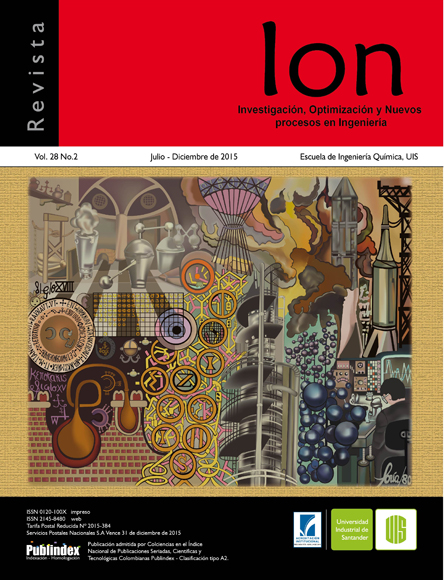Effect of temperature and concentration on rheological properties of mango pulp variety Tommy Atkins
Published 2015-12-30
Keywords
- Rheology,
- Apparent Viscosity,
- Pseudoplastic,
- Index of Consistency.
How to Cite
Abstract
Tommy Atkins mango is one of the varieties most exploited in the industry and marketing global. It is valued for its shelf life and low degradation in handling and transport. The pulp yield is high, between 60 and 75% of the total weight of the fruit, and it is used in the soft drink industry, nectars, compotes and pulp concentrates. This paper shows the behavior and rheological parameters of concentrated mango pulp to different temperatures and concentrations using a Brookfield Modelo DV-II+Pro (R) viscometer. The mango pulp exhibited non-Newtonian pseudoplastic behavior to the temperatures and concentrations studied. The relationship between the shear stress and shear rate was modeled by Power Law or Ostwald de Waele model. Variations in apparent viscosity with respect to temperature and concentration were modeled with the Arrhenius model and power equation, respectively. The results will improve the design of transport equipment and thermal treatment of mango pulp variety Tommy Atkins.
Downloads
References
[2] Holdsworth SD. Applicability of rheological models to the interpretation of flow and processing behaviour of fluid food products. J Texture Stud. 1971;2:393-418.
[3] Vitali AA, Rao MA. Flow properties of low-pulp concentrated orange juice: Effect of temperature and concentration. J Food Sci.1984;49:882-8.
[4] Hernandez E, Chen CS, Johnson J, Carter RD. Viscosity changes in orange juice after ultrafiltration and evaporation. J Food Eng. 1995;25(3):387-96.
[5] Ahmed J, Shivhare U, Raghavan G. Rheological characteristics and kinetics of color degradation of green chilli puree. J Food Eng. 2000;44(4):239-44.
[6] Ahmed J, Shivhare U, Singh, P. Colour kinetics and rheology of coriander leaf puree and storage characteristics of the paste. Food Chem. 2004;84:604-11.
[7] Haminiuk C, Sierakowski M, Vidal J, Masson M. Influence of temperature on the rheological of whole araҫá pulp (Psidium cattleianum sabine). Lebensm Wiss Technol. 2006;39:426-30.
[8] Pelegrine D, Silva F, Gasparetto C. Rheological Behvior of Pineapple and Mango Pulps. Lebensm Wiss Technol. 2002;35:645-8.
[9] Steffe JF. Rheological methods in food process engineering. 2 ed. Estados Unidos: Freeman Press; 1996.
[10] Dak M, Verma R, Sharma G. Flow characteristics of juice of “Totapuri” mangoes. J Food Eng. 2006;76:557-61.
[11] Branco IG, Gasparetto C. A response surface methodology applied to the study of temperature effect on the rheological behavior of ternaries mixtures with mango pulp and orange and carrot juices. Ciênc Tec Alim. 2003;23:166-71.
[12] Malkin A, Isayev A. Rheology: Concepts, Methods, and Applications. 2 ed. Canadá: ChemTec Publishing; 2012.
[13] Mackey KL, Ofoli RY, Morgan RG, Steffe JF. Rheological modeling of potato flour during extrusion cooking. J. Food Proc. Eng.1989;12:1-11.
[14] Dak M, Verma R, Jaaffrey S. Effect of temperature and concentration on Rheological properties of “Kesar” mango juice. J Food Eng. 2007;80:1011-5.
[15] A.O.A.C. Official Methods of Analysis of the Association of Official Analytical Chemist. Estados Unidos: Editorial Association of Official Analytical Chemists; 1990.
[16] Ramos AM, Ibarz A. Thixotropy of orange concentrate and quince puree. J Texture Stud.1998;29(3):313-24.
[17] Sharma S, Le Maguer M, Liptay A, Poysa V. Effect of composition on the reological properties of tomato thin pulp. Food Res Int.. 1996;29(2):175-9.
[18] Krokida MK, Maroulis ZB, Saravacos GD. Rheological properties of fluid fruit and vegetable puree products: compilation of literature data. Int J Food Properties. 2001;4(2):179-200.
[19] Khandari P, Gill BS, Sodhi NS. Effect of concentration and temperature on the Rheology of mango pulp. J. Food Sci. Technol. 2002;39(2):152-4.
[20] Rao MA, Bourne MC, Cooley HJ. Flow properties of tomato concentrates. J Texture Stud. 1981;12:521-38.
[21] Dak M, Charan R, Kumar M. Mathematical models for prediction of rheological parameters of pineapple juice. Int J Food Eng. 2008;4(3):1-16.
[22] Dak M, Charan R, Jaaffrey SN. Rheological properties of tomato concentrate. Int J Food Eng. 2008;4(7):1-17.
[23] Vitali AA, Rao M.A. Flow properties of low-pulp concentrated orange juice: effect of temperature and concentration. J. Food Sci. 1984;49;882-8.
[24] Kaya A, Belibagli K. Rheology of solid Gaziantep Pekmez. J Food Eng. 2002;54:221-6.
[25] Juszczak L, Fortuna T. Effect of temperature and soluble solid content on the viscosity of cherry juice concentrate. Int Agrophysics. 2004;18:17-21.
[26] Kaya A, Sözer N. Rheological behavior of sour pomegranate juice concentrates (Punica granatum L.). Int J Food Sci Tech. 2005;40:223-7.
[27] Quek M, Chin N, Yusof Y. Modelling of rheological behaviour of soursop juice concentrates using shear rate–temperature–concentration superposition. J Food Eng. 2013;118(4):380-5.
[28] Toǧrul H, Arslan N. Mathematical model for prediction of apparent viscosity of molasses. J Food Eng. 2004;62:281-9.
[29] Chin NL, Chan SM, Yusof YA, Chuah TG, Talib RA. Modelling of rheological behaviour of pummelo juice concentrates using master-curve. J Food Eng. 2009;93(2):134-40.
[30] Chuah T, Ling H, Chin N, Choong T, Razi F. Effects of temperature on Rheological Behavior of Drgaon Fruit (Hylocereus sp.) Juice. Int J Food Eng. 2008;4(7):1-28.

